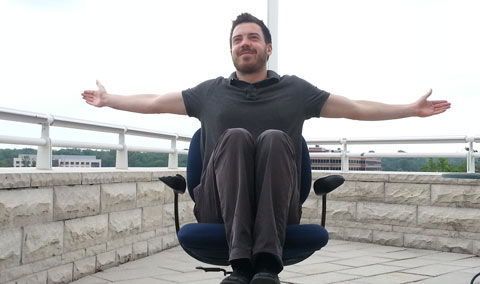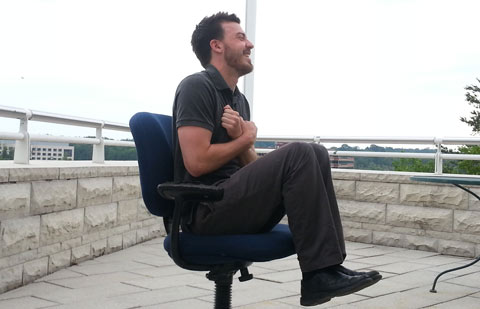Office Chair Physics
See how the position of your body can speed things up — or slow them down — when you’re goofing around at your desk.
What You Need
- A rotating office chair or stool
- A buddy
- Plenty of space
What to Do
Have a seat in the office chair. Make sure that your feet are tucked in and not touching the ground. Stretch your arms out wide and have your buddy give you a little spin on the chair. Now, pull your arms in close to your chest, and see what happens!

Start with your arms out wide, then let your buddy take you for a spin.
What's Going On?
You should notice that as soon as you pull your arms close to your body, you start to spin faster! And if you put them back out, you slow down again. This is because when you rotate (or do any motion!) you have something called momentum.
You can think of momentum as a measurement of how hard it is to stop a moving object. For example, if you’re running quickly, it takes more effort to come to a stop than it does if you’re running slowly. In that case, your momentum depends on your mass and speed. The higher speed running has a higher momentum than the lower speed running.
When you are rotating, you’ve got a quality called angular momentum, which depends on your angular velocity — your speed around the circular motion — and a quantity called moment of inertia. Moment of inertia measures how much your body will resist a change in angular velocity, and it's related to how your mass is distributed. Consequently, moving your arms in and out changes your moment of inertia.
Momentum is always conserved; consequently, during a motion, when one quantity changes (like your moment of inertia) the other must also change to make up for the difference.
Angular Momentum = Angular Velocity x Moment of Inertia

We clearly had too much fun with this experiment.
Can you guess what happens when you pull your arms in? You’ve decreased your moment of inertia. So, to conserve your angular momentum, your speed goes up! When you put your arms back out, your moment of inertia goes back up, so your speed goes back down, conserving your angular momentum!
Apply It!
Where else do you see angular momentum in play? Think about an ice skater doing a spin!
- Aliya Merali














